Making the Spinning Tornado Costume
Making a Wearable Tornado Costume which spins while you walk
By Rob Cockerham | Originally written November 2014 |
My best costumes have had these two properties:
- Some character or essence that people already love
- Use some unexpected engineering
Inspired by oversized costumes I've been seeing lately, I decided to try a tornado costume. The engineering feat would be to get it to spin around like a top, with me inside.

Adding a motor into a costume has never been my strong point. I have had some experience with small motors, tying the motions of a display to the tiny rotating shaft of an electric motor. But I wasn't confident that a battery-powered motor was the right choice.
Almost a year before the costume needed to be finished, I was dying to know if it could be done. Could I build a costume which spins?
In November, my plumbing got clogged.
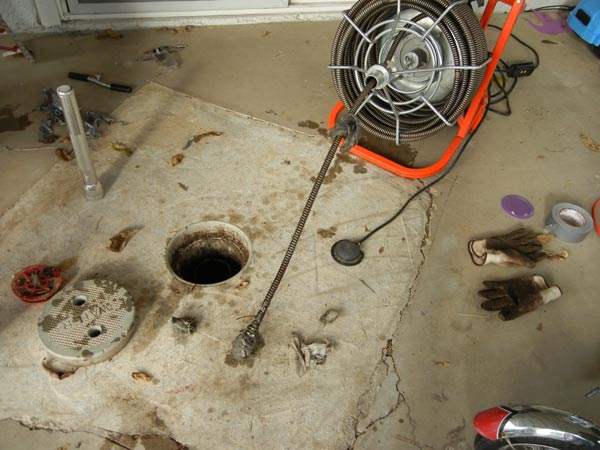
Sitting near an open sewer pipe, feeding a 50' plumbing snake into the ground, I realized I could easily transfer the twisting power from my own hand to the spinning axle above my head. I'd use a helical torsion spring.

Building a Shoulder Harness
I began with my usual Pvc pipe shoulder harness. For this one I built a wooden template, so my pipe bends would be even.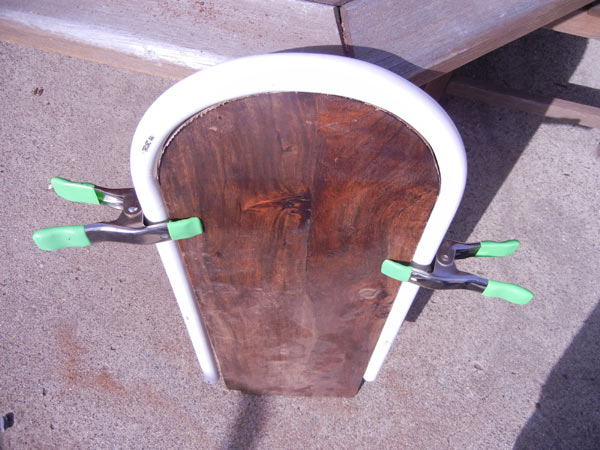
I heat pvc pipe with a heat gun until it becomes soft, then I bend it around a radius. When it cools, the bend stays in the pipe. This had to be a sturdy support for my tornado, so I overbuilt it a bit, ensuring that the pipes fit snugly around my body.
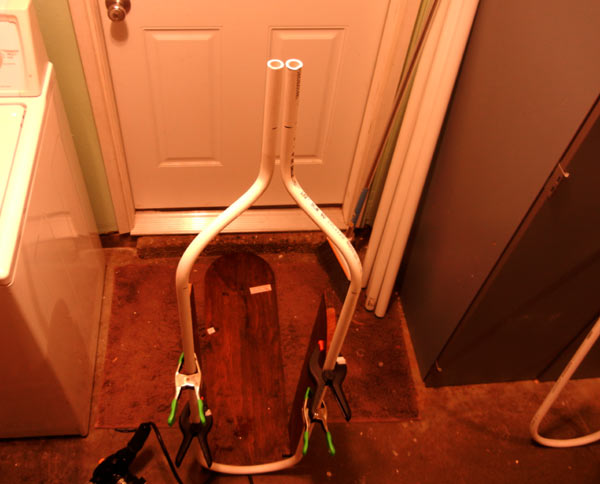
The goal of this harness was to support an open ring (a collar) directly above my head. This is where a bearing of some kind would allow the tornado support to spin around above me, like the blades of a helicopter.
I used a $8 toilet auger, turned upside down. It seemed to be the exact right size to power my spinning contraption.

My harness had four tubes extending upwards, nearly meeting above my head. In that spot I added a 2" collar, which would hold a shaft in place. The shaft was another piece of pvc, ending in a four-way cross at the top.
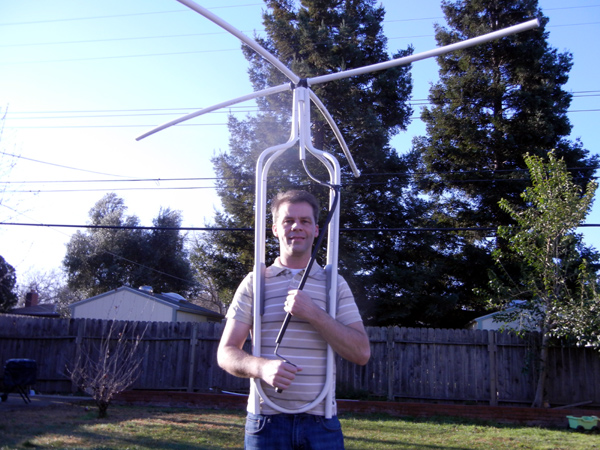
At this stage there was no bearing, the turning part would just rub along the top of the harness collar.
I attached the auger with duct tape for a test spin. It worked! All I needed now was a ring around the top and a conic curtain of fabric to hang down from it. I didn't actually know how to make a cone of fabric, so I dissected a party hat to see how it was made.
Using the height and radius of the top and bottom rings, calculated the circumference of the rings, then using the desired height, projected where the imaginary apex of his cone would fall. Then I laid out three wide strips of gardening fabric and taped them together with black duct tape. The shape I needed could be described as a fat arc.
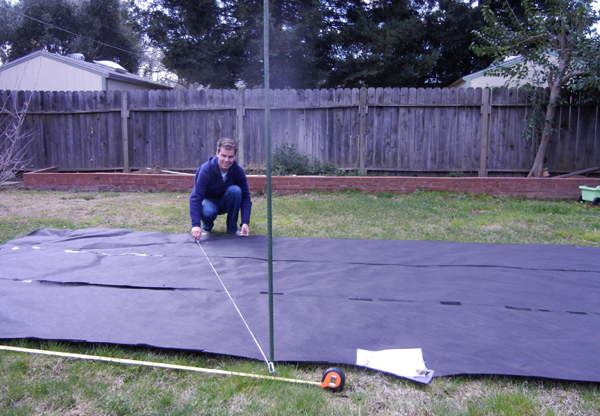
I tied a string to a stick and stuck one end of the stick into the ground on the edge of my field of fabric. This point was my imaginary apex. Now all I had to do was to draw two curved lines on the fabric, one with a four-foot string and one with a nine-foot string, defining the top and bottom of my tornado storm cloud.
My rough sketch had a storm cone with an eight-foot diameter at the top.
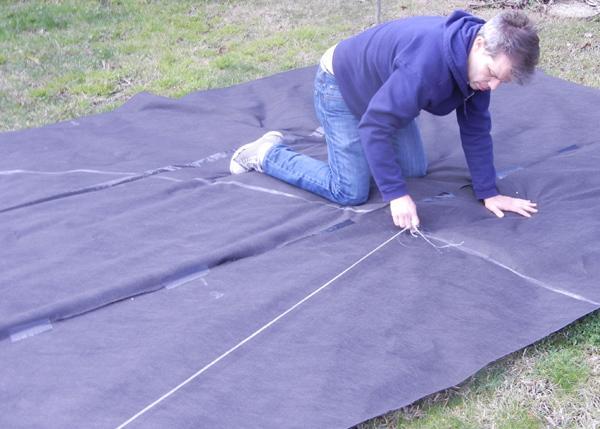
I wanted the costume to be gigantic, but not SO gigantic that I had to rent a truck to get it to the contest. I also needed to be able to squeeze through regular 36" wide doors.
The arc of black fabric for the surface of the tornado.
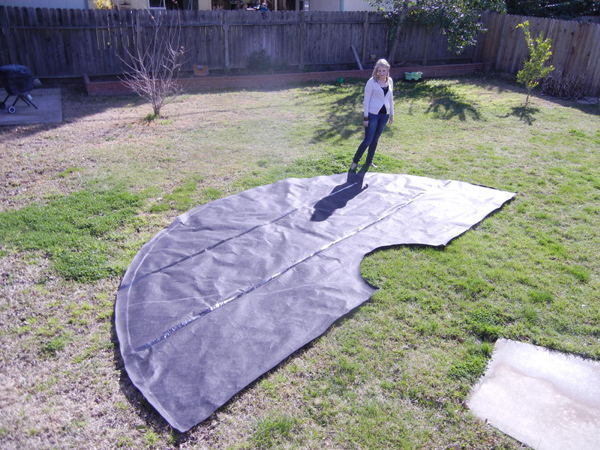
I began work on the top ring.
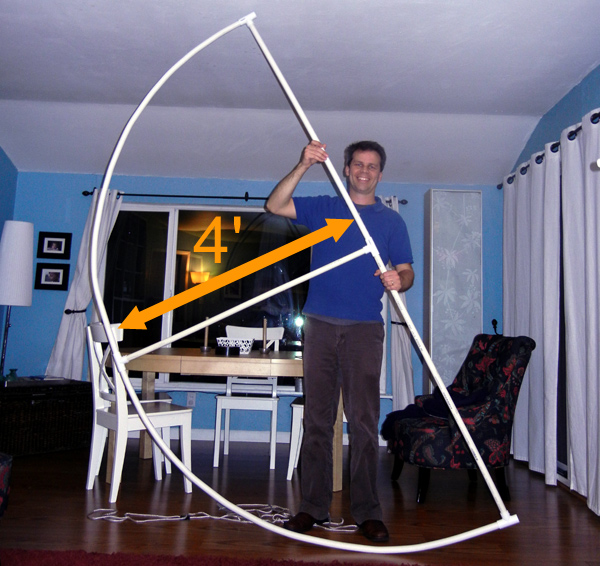
As I built the top rings, I realized that my illustrations had mislead me. A ten-foot circle was obscene. Even an eight-foot circle was ridiculous.

To get a more accurate idea what would look best, I dropped two strings from the ceiling and fastened them to the floor near my feet. Stacy snapped photos to give me a view into the ideal dimensions of a tornado. The strings are pretty hard to see on film, so I have highlighted them with yellow lines above.
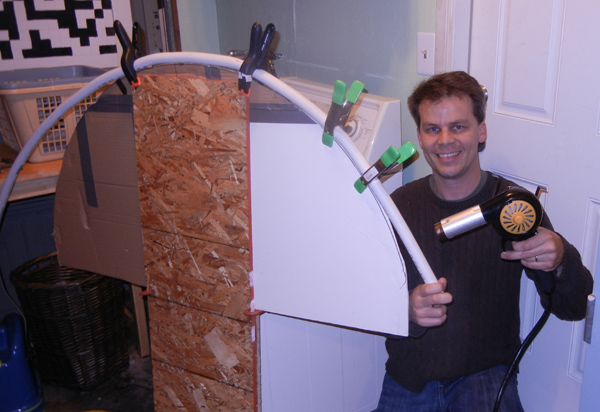
I settled with a four-foot diameter top. The funnel cloud simply looked better when it was tall and thin.
To make the costume fit into our SUV, I needed to make the tornado break down into two or more large pieces. This was a serious engineering concern which had to be considered from the very beginning of the project. I could seperate the curtain from the harness, but I'd have to be able to re-assemble it by myself while I was wearing it.
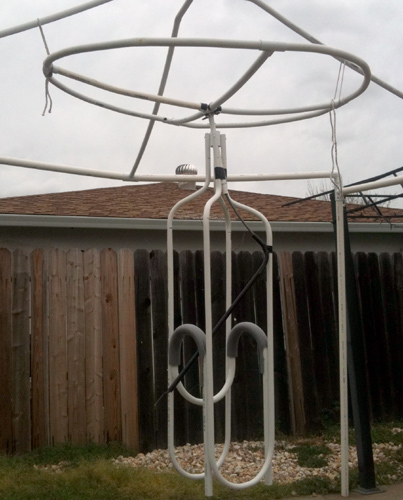
I reinforced the black fabric with the strongest fabric I could think of, this orange plastic fencing material. Tyvek would have also been a good choice, but I wanted the surface of the funnel cloud to be a little more resistant to folding, so that it wouldn't twist up at the bottom.

Some kind of industrial long arm quilting machine would have been useful here, to bind the plastic fencing to the black plastic. I used zip-ties and spray glue.

My high-friction bearing wasn't working well. I added a lazy-susan turntable. This is a much more reliable mechanism.

Next I used self-tapping screws to screw the top edge of the fabric curtain to the helicopter blade wheel. I was skeptical that the fabric would actually cascade down into a conic shape, but sure enough, the geometry was correct and a tornado shape emerged!

Once the curtain was attached, I slipped into the curtain and connected the harness for a test spin. It didn't want to spin. It wasn't caught on anything, it just had a lot of inertia, and my little auger springs were coming unwound trying to push it into motion. Crap.

I needed to upgrade my auger. I had three options:
- Buy a heavy-duty auger with a more substantial tortion spring
- Build a heavy-duty crank with a more substantial tortion spring
- Cobble together another way to tranfer rotational energy

I tried all three.
I bought a $33 toilet auger, with a very impressive spring and set of handles, but it was too long for the harness, and I would have had to route the spring into a circle to get it back down to the connection point of the rotor.
I bought a solid wooden dowel and two springs, twisting them together to make my own offset crank.
I explored the possiblity of foregoing springs altogether and using 1/2" sockets to turn my rotor. Harbor freight tools had all the parts available, at ridiculously low prices.
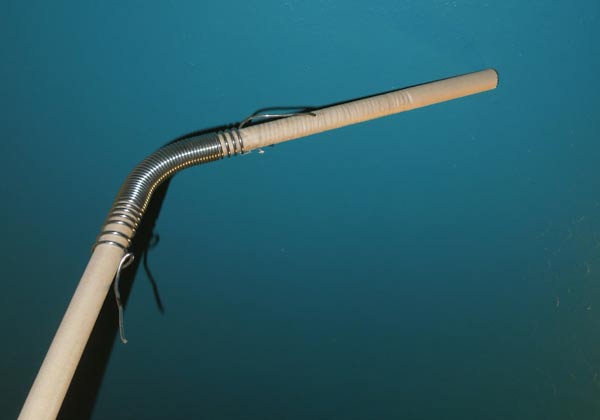
The wooden dowel homemade auger was my favorite solution, probably because it was the cheapest. I found springs which fit snugly around a dowel, but that seemed hearty enough to withstand a great deal of twisting without folding or buckling. I used small screws and washers to make sure the springs stayed affixed to the dowels.
Unlike the toilet auger, my homemade crank tended to straighten itself out. I needed a loop to put it through, so I taped a section of 2" PVC pipe to my harness. To create the crank handle, I bent a short piece of pipe, remembering to slide a slightly larger bit around it, like a sleeve. Having a spinning sleeve for a handgrip makes the cranking easier, so I wouldn't have to reposition my hands with each turn. I added a second sleeve above the crank and attached it to the lower end of the dowel. It was a little ugly, but had cost less than $10 in materials, and would fit into the confines of my tornado with ease.

To ease entry and exit, I bought a long black zipper.

I had a plan for installing the zipper: First I would attach the closed zipper to the inside wall of the tornado curtain. Next I would slice through the fabric, revealing the closed zipper, which would be holding both halves of the fabric at the exactly correct spot whenever the zipper was closed.
Undetered by my lack of a sewing machine, I used hot glue to stick it in place, laying down a line of glue for each half of the zipper. When I attempted to cut the fabric, I realized my error: It doesn't take a lot of hot glue to completely lock up a zipper.

I hated to buy another zipper immediately, so I went online to find a solution. Guess what? The internet had one. Here it is:
Rubbing Alcohol dissolves Hot Glue.
Worked like a charm. I spent about half of an hour dabbing isopropol alcohol onto the zipper, peeling off the glue and working the zipper up.
With the zipper installed and working, I was happy with the engineering, and decided to embark on one of the most fun parts of building costumes: The appearance.
My first thought was to use building insulation to simulate the cloudy exterior of a tornado. I wanted an irregular appearance, which I thought fiberglass would provide beatifully.
Unfortunatly, fiberglass is terrible to work with, and terrible to use. It gets on your skin and itches. It also has an inhalation hazard.
I forged ahead. Fiberglass, I could deal with the problems. I wanted the tornado to look like a swirling cloud, and I knew would look better than the upholstery foam I could buy in a fabric store.
But I went ahead and bought the upholstery foam anyway.
First I tried using spray paint to make pink fiberglass white, but it didn't work well. Luckily Lowes sells Manville building insulation, which is bright white! It would look perfect!

Using thin sheets of building insulation and lots of spray glue, I was able to create a cloud-like tornado exterior. It looked extremely cloudy, but needed a little direction... something to make it look like it was moving.
I decided I needed to add some thin bands of cloud.

For strips, the upholstery fiber-fill sheeting was perfect. I spent an evening cutting it into long strips, then began attaching it to my funnel cloud with hot glue.

It looked great! The two layers of cloud worked well together, the static cloud with the strips of cloud wrapped around them. To create a spiral effect, I kept an even slope in mind dropping from left to right.

There were a lot of strips of fabric, but the more I added, the better it looked. I added them all.

And, like an idiot, I was so excited to be finished gluing the strips that I immediately began painting it. Here's a tip for you: Don't paint in the dark.
I added layers of black, gray and white paint, and ended up with a tiger-striped ice-cream cone that had obviously just been spray-painted. Damn. That needed a fix.
I had another problem as well. It didn't spin well. It spun slowly.
I had assumed that by hand-cranking it, I'd be able to tackle the inertia of anything by slowly winding it up to speed. I can push a car, if I treat the weight with respect, so it seemed logical that I'd be able to gently nudge a cone around, even if it weighed 100 lbs. As long as I continued to apply force, it should spin faster and faster, right?
No.
It wasn't just the weight. I was dealing with friction.
This was something I'd have to figure out if I was going to have a chance in the costume contest.
It probably isn't very obvious how I can see. I cut about 10 holes in the curtain, around eye level. When the tornado is still, I can see with tunnel vision through one or more of these holes.
When the tornado is spinning, I get a 10 frames per second rotoscope view of the world.
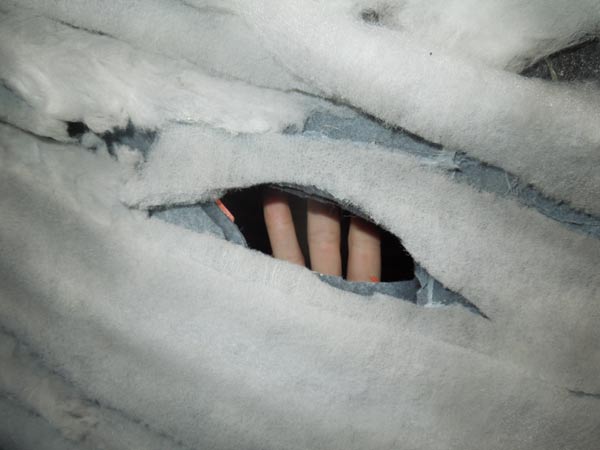
I had a problem. The tornado would turn slowly, but the cloth funnel wouldn't build inertia and wouldn't speed up.
I had too much resistance, and my drive shaft was dodgy and slipping.

I attempted to make the crank drive easier. I removed some of the cowling I had been using to constrain the crank drivetrain. I also added screws, making it impossible for the springs to slide over the dowel instead of turning it, even at very high torque.
To lower friction, I cut a few inches from the bottom of the tornado cone.
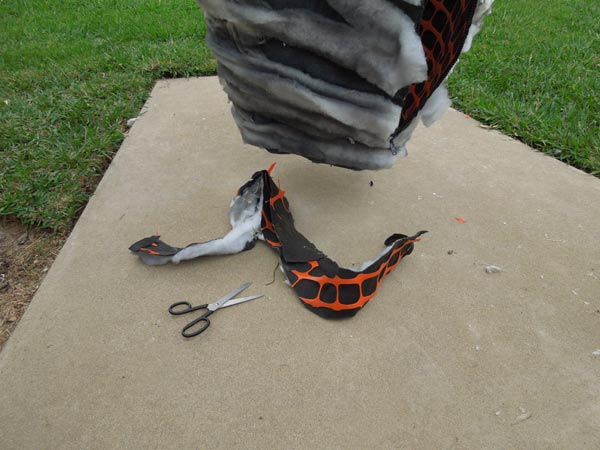
The black cloth had been very close to my legs, and inevitably curled into it, slowing the rotation of the cone. By removing a few inches, I hoped to give myself a little more space, lessening the frequency of tornado-leg collisions.
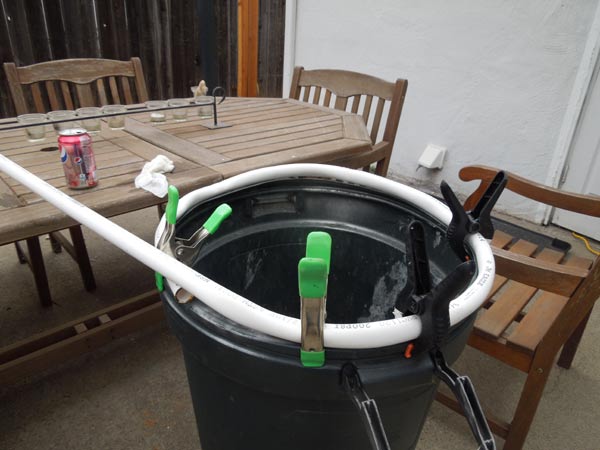
I also bent and added a PVC ring at the bottom of the cone, so that even if my legs did touch, the contact wouldn't slow the tornado as much.

It looked great! This ring was about 18" around, and kept the bottom of the funnel nice and round. I used zip ties, and later hot glue, to keep it in place at the bottom margin of the cone.
On my next test spin, this ring seemed to help. I had eliminated some of the drag, but my dowel & spring crank wasn't able to handle this lower amount of torque either. The top spring would twist out of its position, unable to coax the giant conic curtain into orbit.

My next move was to upgrade the crank to a solid-steel solution.
I went to Harbor Freight tools, an oasis for tools I only planned to need one time. There they sold "universal sockets", a bending connection which are the real-world mechanic's solution to the "turn at an angle" proposition.
They also sold extraordinarily long socket extensions. With six pieces, I could snap together a completely new crank, free of springs and engineering question marks. The downside? This upgrade was $60 more than my wood-and-spring option.
There were only 6 days until the costume contest, and my entry was more like a barber pole than a tornado.
I bought the socket extensions. Let's build a heavy-duty tornado crank!

It was quick work to pull out the dowel crank and piece together a stainless-steel version.

The socket drivers are designed to be connected and disconnected. The only connection which had to be fudged was the connection from a 3/8ths inch drive to a 3/4" pvc pipe. I glued a 5/8" dowel inside a 3/4" piece of PVC pipe, then drilled and sunk a lag screw into it.
My socket-driver drive train would turn the head of that lag screw, round and round forever.
This slug fit snugly into the larger PVC pipe which drives the propeller at the top of the tornado. I screwed it into place. To push the bolt, I used a single 3/8" socket. The pieces were snug. I gave them a wrap of duct tape just in case.
I can hear engineers cringing from clear over the internet. This is like driving a ceramic mug with an impact hammer.
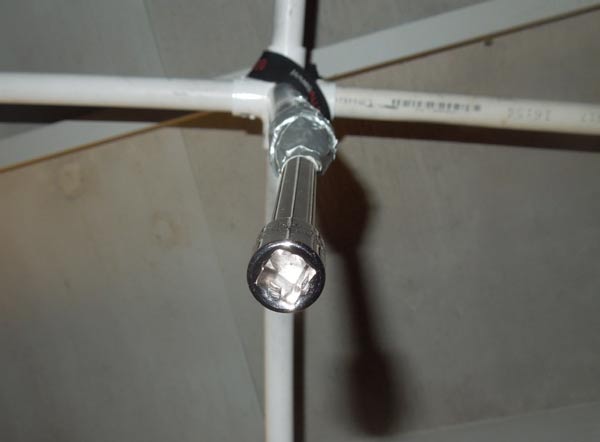
The socket and driver solution didn't leave any spring action in the connection. This tornado had direct steering.
Did it work?
It worked! It looked really amazing in action. Whizzing around like no costume I've ever seen before. If this were an off-Broadway production of Wicked, I'd be the star of the show!
But I was going against some tough competition for a $5,000 prize.
Could this spinning cloud claim the prize against Robots in Disguise? Saturday night I'll find out. I'm going to the Exotic Halloween Ball.
On Friday night, I tried to go to Shawn's Halloween party at the Townhouse, but realized when I got there that I'd have to squeeze into the door and be pegged in a corner all night in this getup. Instead, I walked around the streets of midtown Sacramento, figuring out what I should change before the big money contest on Saturday.
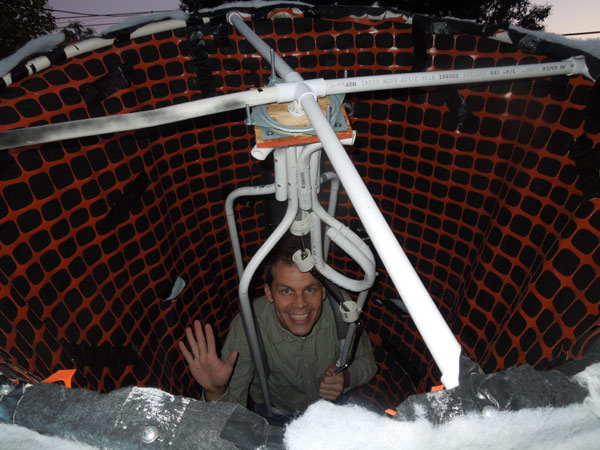
The costume got a great reaction from the public! I was amazed to hear people having difficulty figuring out what the costume was. One unfortunate remark was "spinning garbage".
The universal (swivelling) socket connectors I had bought were crap. The pins in them wriggled free, making it impossible to spin the tornado. Goddamn Harbor Freight!
Also, the harness was too wide on my shoulders.
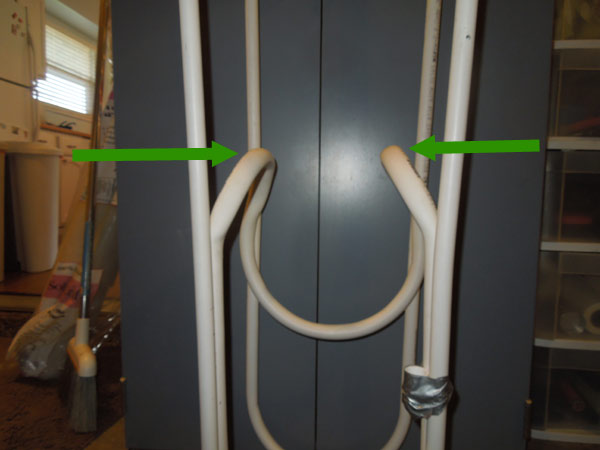
I came home and got to work making some improvements. I bought new universal socket connectors from Home Depot, bent the harness to fit my shoulders better, and added a giant pair of googlie eyes.

Googlie eyes have been very good for me in the past. My Fandango paper bag hand puppet costume won the Zone Ball costume contest a few years back, and my "The Money you Could be Saving with Geico" costume had placed second. Crowds love giant googlie eyes!
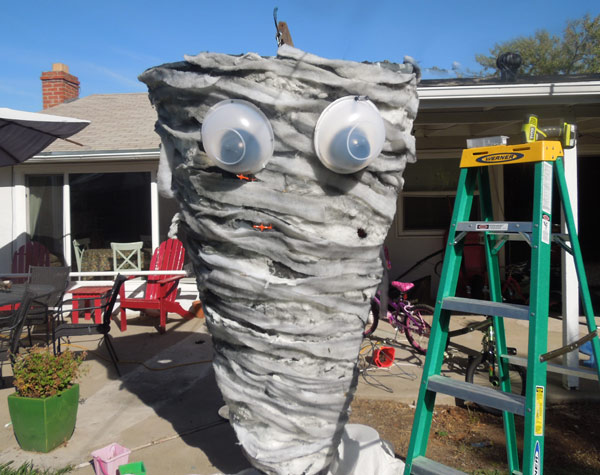
I had bought a few tiny people to glue to the tornado too. The were very small, so you can't see them in these photos.
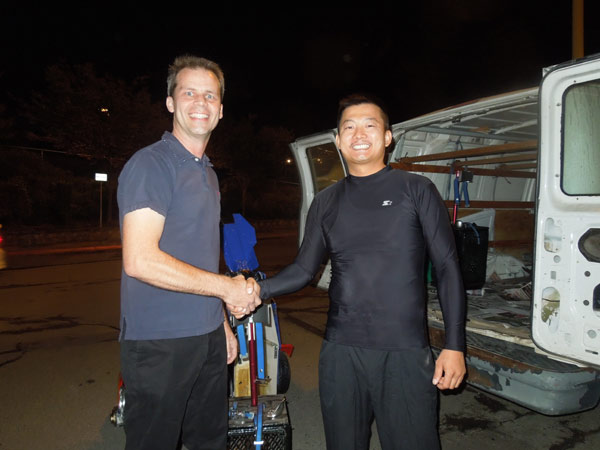
Finally, on Saturday night I headed out to the big contest at Cal Expo. This was the "Exotic Ball", a huge party in a warehouse with a $5,000 top prize for best costume. In previous years the money had been split between 1st, 2nd and 3rd place, but this year it was winner take all!
I arrived right at the beginning of the party. Francois was there unloading his van. He was setting up his Transformer costume. He was probably going to be my fiercest competition inside. We chatted a bit, then I went back to my car and got dressed.

One of his posse helped me get this great motion blur photo of the tornado costume in action! Isn't that a great shot!?
The tornado costume is really difficult to see out of. I was kicking myself immediately. Why didn't I give myself a larger viewport(s)?
Early at the party I squeezed through the entry doors and made it over to the preliminary judging stage. There was no line, and I had immediate help getting up the stairs to show off the tornado.
Everyone seemed to love it! I was really going to have fun being able to reveal that the costume would spin.
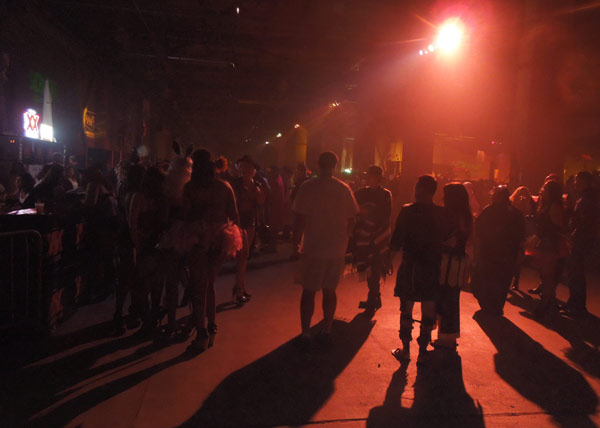
I impressed the judges enough to win a finalist badge! Awesome! Now I would wait. The costume contest was around midnight.
Unfortunately, the tornado costume was an anti-social costume. I could hardly talk to people. They could barely hear me and I could barely hear them. It was also fragile enough that I was afraid to wade into big crowds as I usually do. I was limited to squeezing handshakes and giving fiberglasstic tornado hugs.

This Wizard of Oz group was extremely glad to see me. I handed one of them my camera and then watched as they passed it around and took this photo. I was not in any position to recover my camera if one of their munchkins had taken it. Luckily it came back with this nice group shot.
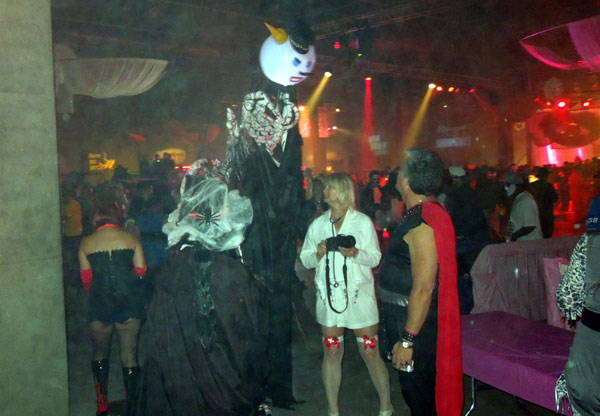
I scanned the crowd for great costumes. There weren't many. There were a lot of sexy asses and laced corsets, but not a lot of great, stage-ready contest-winning costumes.
The Evil Jack in the Box costume above was tall, but made of white balloons. I could beat that.
It was difficult to get the Tornado costume on and off, so I didn't drink. It turns out that there is a direct correlation between how much you drink and how much you have to pee.

On my one bathroom break, I spotted these three, a duct tape alien, a duct tape Predator and an excellent triangle head costume. They also had finalist lanyards.
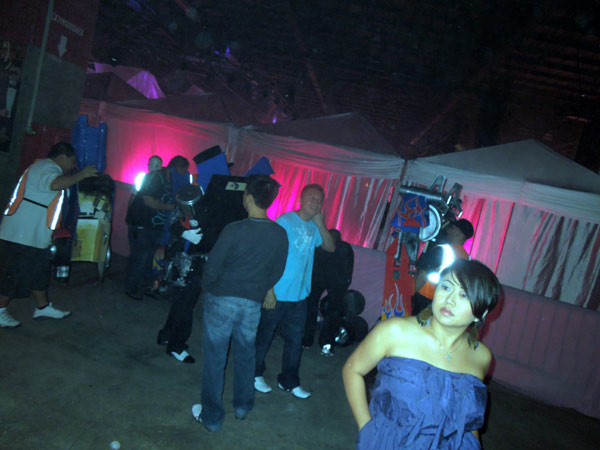
Inside, time was slooooowly passing. I was having an easier time reaching people via text than I was connecting with people at the party.
Francois' group began setting up the parts to his Transformer costume.

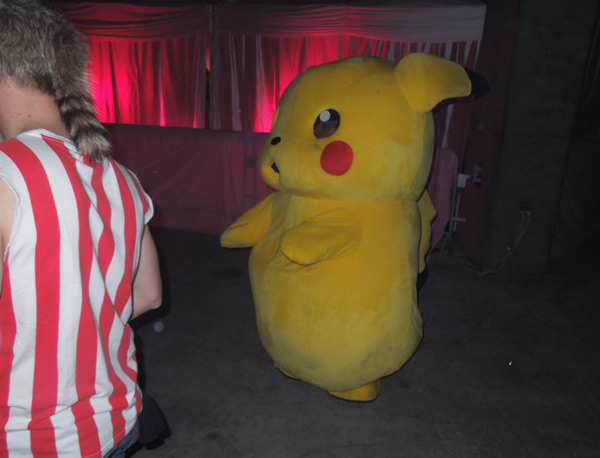
As midnight approached, the other finalists arrived at the side of the stage, queueing for the costume contest. Francois' Transformer looked great, and this perfect Picachu was an adorable bundle of competition.
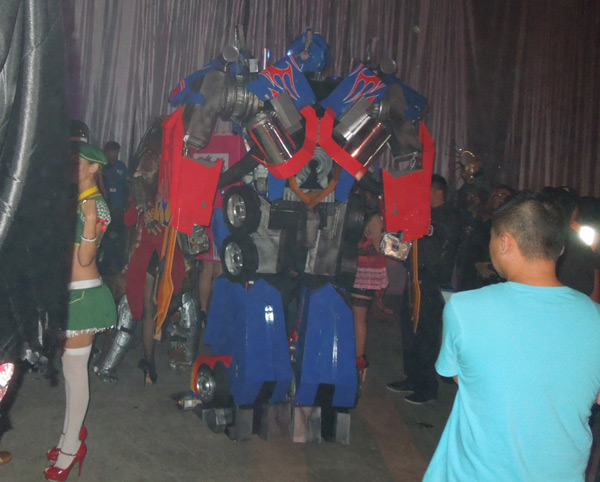
Waiting for the contest to start, Optimus Prime got the lion's share of attention. I'm sorry that I didn't get a better photograph.
Optimus Prime was an extraordinarily detailed costume, probably 12 feet tall, with two giant swords. I couldn't beat him. The crowd roared for my enthusiastic spinning, but the Transformer ruled the day. Optimus Prime won!
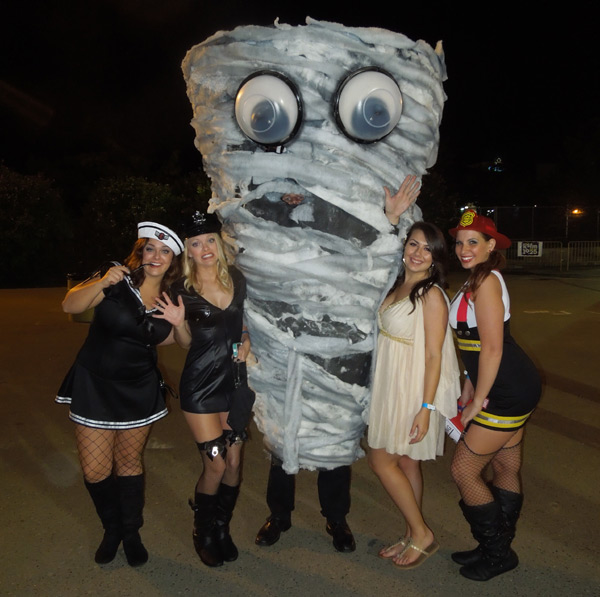
After the contest, half-naked angels helped me offstage and into the VIP area. I had a pretty good run of feedback, including "your costume was my favorite", and "How did you make it spin?!" I was disappointed in the loss, but relieved that I didn't lose to a trio of Cosby kids or to Cheech and Chong.
On the way out of the party, I got a few more photos, including this one. Ignoring these comely lasses for a moment, note how my costume was thrashed. the tornado had a weird frown! Had it been thrashed onstage during the contest? I had no idea.
The big money was gone, but there were a few more contests to enter before Halloween was over.
With Halloween falling on a Wednesday, all the big contests had been on Saturday, with smaller parties happening at clubs on Halloween night. I found one with a $1,000 contest.
But during the day, I showed up to work.
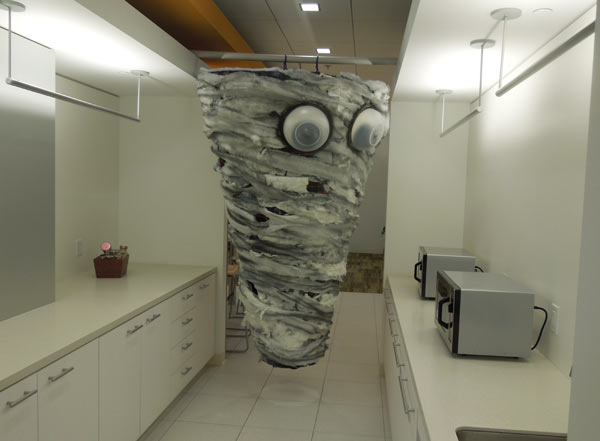
I work at Intel in Folsom. There is a large campus there of seven buildings, and they have an organized costume contest on Halloween. It's a little ridiculous to wear a costume to work that you can't work in, but I figured I could get away with it in Intel's engineering culture.
I hung it up in the break room for much of the day.

It was great to wear the costume in fully lit rooms! Above you can maybe get an idea of what my view of the world was like within the tornado.
By sheer coincedence, Hurricane Sandy had hit the east coast the night before Halloween, killing about a hundred people and causing billions of dollars worth of damage. I repeated a few times that I was a tornado, and I'd like to think that people could tell I didn't build this costume in a week, but the comparison was inescapeable.
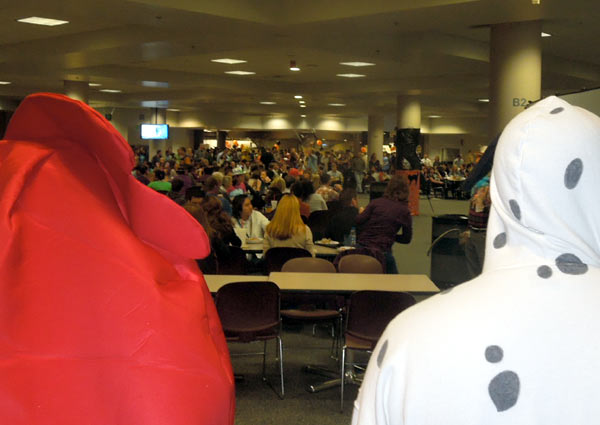
It was a big event during lunch, and I came away with first place, a $100 VISA gift card!

I got home around six and went out trick-or-treating with the kids. Why do we give out candy? Couldn't we give out Legos instead?
Before the kids fell asleep, I was headed out again, eager to compete in a final halloween contest.
Well, to be honest, I wasn't looking forward to it. I was tired. But I'd have to be dead to skip this shot to win $1,000.
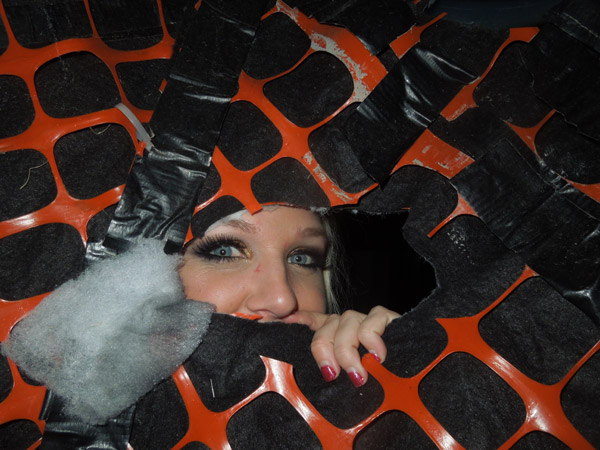
I had never been to the Parc Ultralounge, but with that name I expected it to be self-important and expensive.
It wasn't pretentious! It was nice! Everyone I met was friendly and helpful and clearly having a good time. Rain had begun to fall outside, and the club had a warm "come in from the storm" vibe.
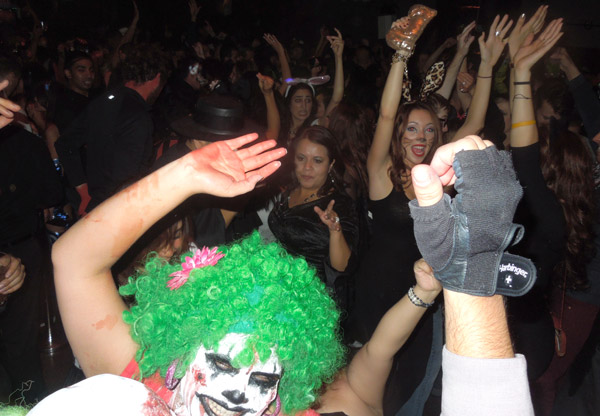
And everybody loved the tornado costume. The club had double doors and high ceilings, the perfect place for my ridiculous getup.
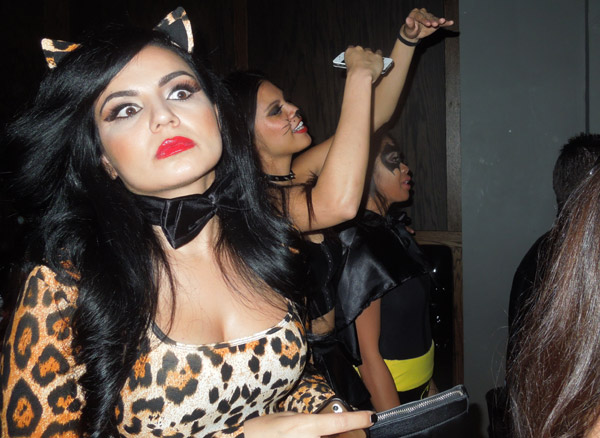
I really had fun. There were no other supersized costumes, so I had a good feeling about the costume contest. To help my chances in the contest, I didn't show off the spin. I reserved the spinning effect of the costume for my time on stage, and it was a hit!
There were only about 200 people in the club, and they lost their minds cheering when I got on stage and the costume started spinning around! I was a shoe-in!
A quick final round gave me the victory! $500 for first place!

I was presented with my prize, and I spent almost another hour in the club. When I did decide to head out, I could barely, barely squeeze through the packed grinding dancefloor. People gave no margin, the floor was PACKED. It took 10 minutes to get to the exit, where I finally crawled out of the costume and took a break.
Halloween was over, it had been two years since my last contest victory, I was estatic. I was also very happy to throw this wet blanket into the car, head home and crawl into bed.
Epilogue
The tornado costume was a success!
The mechanism was not as dependable as I would have preferred. The socket-set connections were good, but I should have welded the final upright link to the metal bolt inside the "propeller" crossbar at the top.
I shouldn't have used insulation. Spray paint helped keep it subdued, but the fibers still caught the air and broke free, flying around inside and outside of the costume. The fiberglass was irritating.
I'm happy to have created a new style of harness for a costume. I hope it inspires other rotating costumes in the future... and I hope I don't have to compete against them.
